Shop talk: the making of Handmade 2015's ‘Rotunda Serotina’ snack bar
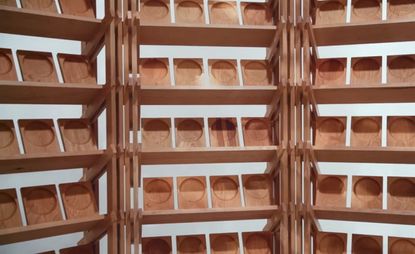
The traditional sweet shop evokes some of the best childhood memories. So, in keeping with this year’s Handmade focus on food and entertaining, we set out to explore a modern, savoury take on the theme through a new, interactive installation designed by Scandinavian architecture firm Kolman Boye.
To recreate the experience, the architects tapped into their own childhood memories, as well as images of old sweet stores, but seen through a decidedly architectural lens. ‘One of the things we identified very early on as important was the abundance of drawers found in pre-supermarket stores,’ says the firm’s co-founder Victor Boye Julebäk. Playing with the idea of repetition, the team started thinking about drawers, then moved to jars, before finding the perfect solution with a combination of shelving and trays. ‘We started to multiply and something was born,’ adds the practice’s other-half, Erik Kolman Janouch.
Formed in 2013, with a main base in Stockholm and another in Copenhagen, the young studio works with a strong focus on materials and construction. Their attention to physical detail is matched only by their rigorous research into historical references, building methods and forms, which often leads them to unexpected places. Images of humble, industrial architecture were perhaps an unlikely reference in this design process. The functionality and modularity of these pragmatic edifices served as inspiration for the installation, which developed into a dramatic circular tower of shelves, carrying rectangular trays to be filled with snacks.
‘We’re interested in vernacular industrial buildings, like, for example, old Danish brick factories and the Bechers’ anonymous sculptures,’ says Boye Julebäk. ‘Who would look at brick factories when making a candy shop? Their common trait is a clear structure made up from the sum of repeating components, serving an essential idea. It’s a poetic notion analogous to what we tried to achieve in the rotunda.’
Created exclusively in American cherry, the installation was brought to life using the woodworking skills of the Benchmark team. One of Britain’s most technologically advanced workshops for timber milling, carpentry, veneering, metalworking and in-house upholstery, Benchmark helps create beautiful bespoke designs. It also has its own design studio and collection, so its broad-ranging expertise was a perfect match for Kolman Boye’s fascinations. ‘The team really know their woodworking,’ says Benchmark co-founder and managing director Sean Sutcliffe. ‘They had a particular feeling for Japanese joinery and a respect for it.’
Working with cherry wood had its own attractions. The species, readily available in the US though currently underutilised, is long overdue a comeback. ‘There was a time when more than half of everything we produced was in cherry wood,’ says Sutcliffe. ‘Now it’s almost zero. It has become a victim of fashion, but it’s a fantastic wood to work with. The first piece of furniture I ever made was in cherry wood and I’ve loved it ever since.’
Creating something out of a single material was a welcome challenge for the architects, though not wholly uncommon. They often focus on a sole material in their work, in varying scales and typologies. They also know their woods – in fact, a woodworking studio forms part of their office, where they regularly create lifesize mock-ups for projects. Yet, this was their first venture with cherry. ‘What was convincing for us, apart from this being a fantastic project, was the ecological value,’ says Boye Julebäk. ‘Pennsylvania is full of cherry and if we don’t use it, all this amazing material is going to turn into bio-fuel.’
The American Hardwood Export Council (AHEC), the leading international trade association for the US hardwood industry, was our go-to partner for wood guidance and support. AHEC works with over 25 different species, and American cherry stood out as a great option to work with, both for its aesthetic quality and environmental impact. ‘We believe timbers like maple and cherry have a lot to offer and will come back into mainstream use,' says AHEC European director David Venables. ‘We try and promote the widest range of species in the market, reflecting what the forest grows.’
Indeed, AHEC is serious about adopting a balanced approach to using different timber species, as well as championing its products’ environmental profile. ‘Wood processing, from an environmental point of view, has a number of huge advantages. Wood is renewable, stores carbon and is relatively low impact to process. Wood is also unique as it is both a material and a fuel; most wood factories recycle wastage for biomass. This offsetting keeps the carbon impact of wood products to a minimum,’ says Venables. ‘It is our experience that addressing the environmental impacts during processing can also help to streamline physical costs.’
Named, in a nod to its elegant, cylindrical form and the material’s Latin name, Prunus serotina, the installation is made using a combination of Japanese joinery and Nordic carpentry. There is little to no glue involved and, as most of the joints are dry, it can easily be dissembled and reused.
Stretching over 3.7m in diameter and some 4m tall, it includes an impressive 3,084 pieces connected by 1,008 joints. On its shelves sit 528 trays. Scale was one of the project’s key challenges. ‘There are thousands of pieces and everything needs to be very accurate,’ explains Sutcliffe. ‘There’s nowhere to hide. It has been an exercise in using cabinetmaker tolerances but building a huge tower out of it. That was interesting for us to tackle.’
The installation’s circular shelving system was conceived to serve our specially commissioned savoury snacks, created by Tancredi and Alberto Alemagna’s Milanese bistro T’a. The scrumptious biscuits were available in four flavours – rosemary and parmesan, parmesan and paprika, cocoa and Szechuan pepper, and oregano and tomato – and a movable ladder and a centrally placed food container helped with serving. And during the show, there was an added bonus for our guests: they got to keep the cherry wood tray their nibbles came in.
As originally featured in the August 2015 edition of Wallpaper* (W*197)
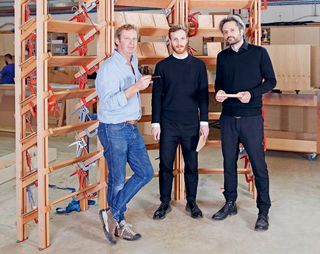
From left: Benchmark co-founder Sean Sutcliffe, Victor Boye Julebak and Erik Kolman.
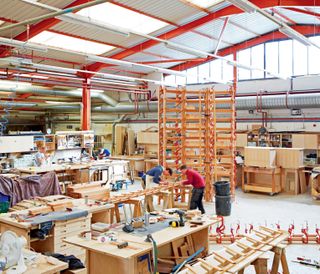
To recreate the experience, the architects tapped into their own childhood memories. ‘One of the things we identified very early on as important was the abundance of drawers found in pre-supermarket stores,’ says the firm’s co-founder Victor Boye Julebäk. ‘We started to multiply and something was born,’ adds Erik Kolman Janouch.

Their attention to physical detail is matched only by their rigorous research into historical references, building methods and forms, which often leads them to unexpected places. The functionality and modularity of these pragmatic edifices served as inspiration for the installation, which developed into a dramatic circular tower of shelves.

‘Rotunda Serotina’ is made using a combination of Japanese joinery and Nordic carpentry. Stretching over 3.7m in diameter and some 4m tall, it includes an impressive 3,084 pieces connected by 1,008 joints. On its shelves sit 528 trays.
Wallpaper* Newsletter
Receive our daily digest of inspiration, escapism and design stories from around the world direct to your inbox
Ellie Stathaki is the Architecture & Environment Director at Wallpaper*. She trained as an architect at the Aristotle University of Thessaloniki in Greece and studied architectural history at the Bartlett in London. Now an established journalist, she has been a member of the Wallpaper* team since 2006, visiting buildings across the globe and interviewing leading architects such as Tadao Ando and Rem Koolhaas. Ellie has also taken part in judging panels, moderated events, curated shows and contributed in books, such as The Contemporary House (Thames & Hudson, 2018), Glenn Sestig Architecture Diary (2020) and House London (2022).
-
 The visual feast of the Sony World Photography Awards 2024 is revealed
The visual feast of the Sony World Photography Awards 2024 is revealedThe Sony World Photography Awards 2024 winners have been revealed – we celebrate the Architecture & Design category’s visual artists
By Ellie Stathaki Published
-
 Don’t Move, Improve 2024: London’s bold, bright and boutique home renovations
Don’t Move, Improve 2024: London’s bold, bright and boutique home renovationsDon’t Move, Improve 2024 reveals its shortlist, with 16 home designs competing for the top spot, to be announced in May
By Ellie Stathaki Published
-
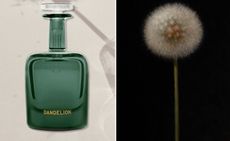 Perfumer H has bottled the scent of dandelions blowing in the wind
Perfumer H has bottled the scent of dandelions blowing in the windPerfumer H has debuted a new fragrance for spring, called Dandelion. Lyn Harris tells Wallpaper* about the process of its creation
By Hannah Tindle Published
-
 Veuve Clicquot and Magnum Photos salute the sun
Veuve Clicquot and Magnum Photos salute the sun‘Emotions of the Sun’, a photography exhibition by Veuve Clicquot and Magnum Photos, debuts in Milan, accompanied by a sun-themed tasting menu
By Simon Mills Published
-
 Celebrate 160 years of Martini, the iconic aperitivo
Celebrate 160 years of Martini, the iconic aperitivoWe mark 160 years of Martini & Rossi, creator of the original Martini Rosso vermouth, a perfect blend of fragrant botanicals and sweet wines
By Tianna Williams Published
-
 Cin cin: discover the story behind Campari, Milan’s signature aperitivo
Cin cin: discover the story behind Campari, Milan’s signature aperitivoWhere better to indulge in the delights of the Italian golden hour than Milan, the home of Campari? We trace the origins of the city’s signature aperitivo
By David Taylor Last updated
-
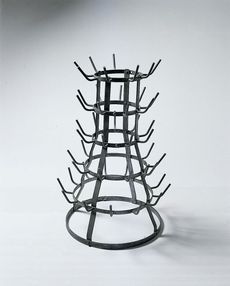 Milan’s Triennale Design Museum spills the beans on the art of food (and food of art)
Milan’s Triennale Design Museum spills the beans on the art of food (and food of art)By JJ Martin Last updated
-
 Buccellati sets the table for conviviality at Milan Design Week 2022
Buccellati sets the table for conviviality at Milan Design Week 2022Designers Dimorestudio, Ashley Hicks, Chahan Minassian and Patricia Urquiola create spectacular dinner table designs for Buccellati’s Milan Design Week exhibition, ’Il Galateo – a journey into conviviality’
By Mary Cleary Last updated
-
 Meta is poised to be Milan’s new food destination
Meta is poised to be Milan’s new food destinationMeta is a new culinary concept space that brings the best of Italian food and design together in one place
By Mary Cleary Published
-
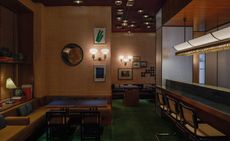 Dimorestudio’s much-anticipated Langosteria Cucina opens in Milan
Dimorestudio’s much-anticipated Langosteria Cucina opens in MilanLangosteria Cucina is the new Milan restaurant designed by Dimorestudio that promises to be one of city’s next hotspots
By Laura May Todd Last updated
-
 We’re at the sharp end of sophisticated postprandial entertaining with our tool kit
We’re at the sharp end of sophisticated postprandial entertaining with our tool kitBy Pei-Ru Keh Last updated